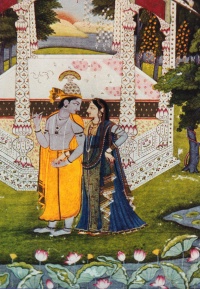Krishna: Difference between revisions
No edit summary |
|||
| Line 6: | Line 6: | ||
=='''Krishna''', in Gurmat== | =='''Krishna''', in Gurmat== | ||
The word | In Gurmat, Krisna is Formless. The word krisna means dark or black in colour. In Gurbani, Mann(Attentions, soul) is Black in color, if it does not listen to inner soul. Mann(Attentions, soul) is attributed as Black in gurbani and Krisna is black too, but Ram is not attributed as black but it is attributed as present in Light not Dark. The Dark part of our soul is attributed as krisna and light part is attributed as RAMA. Jeev have two parts KRISHNA and RAMA. Positive is RAMA and Negative is krishna, but if these both two are one then the next step is to get god. First we have to finish negativity from ourself and work positively as our RAMA guided us from inside. Gurbani says there are MANY KRISHNAS and there are MANY RAMAS too. | ||
==Both word and Devta== | ==Both word and Devta== | ||
Revision as of 11:30, 25 July 2010
| ਜਗ ਦਆਪਰ ਆਇਆ ਭਰਮਿ ਭਰਮਾਇਆ ਹਰਿ ਗੋਪੀ ਕਾਨਹਹ ਉਪਾਇ ਜੀਉ ॥ |
| Jug ḝuĝpur ĝiĝ bẖaram bẖarmĝiĝ har gopī kĝnĥ upĝė jīo. |
| The Brass Age of Dwaapar Yuga came, and people wandered in doubt. The Lord created the Gopis and Krishna. |
Krishna, in Gurmat
In Gurmat, Krisna is Formless. The word krisna means dark or black in colour. In Gurbani, Mann(Attentions, soul) is Black in color, if it does not listen to inner soul. Mann(Attentions, soul) is attributed as Black in gurbani and Krisna is black too, but Ram is not attributed as black but it is attributed as present in Light not Dark. The Dark part of our soul is attributed as krisna and light part is attributed as RAMA. Jeev have two parts KRISHNA and RAMA. Positive is RAMA and Negative is krishna, but if these both two are one then the next step is to get god. First we have to finish negativity from ourself and work positively as our RAMA guided us from inside. Gurbani says there are MANY KRISHNAS and there are MANY RAMAS too.
Both word and Devta
Krishna (कृषढ़ण in Devanagari, kṛṣṇa in IAST, is a deity worshipped across many traditions in Hinduism in a variety of perspectives. While many Vaishnava groups recognize Krishna as an avatar of Vishnu, other traditions within Krishnaism consider him to be svayam bhagavan, or the Supreme Being.
The Sanskrit word kṛṣṇa means "black", "dark" or "dark-blue". It is often used as a name to describe someone with dark skin. Krishna is often depicted in murtis (idols) as black, and is generally shown in paintings with a blue skin.
Krishna is often depicted as an infant or young boy playing a flute as in the Bhagavata Purana, or as a youthful prince giving direction and guidance as in the Bhagavad Gita. The stories of Krishna appear across a broad spectrum of Hindu philosophical and theological traditions.
They portray him in various perspectives: a god-child, a prankster, a model lover, a divine hero and the Supreme Being. The principal scriptures discussing Krishna's story are the Mahabharata, the Harivamsa, the Bhagavata Purana and the Vishnu Purana.
| ਆਪੇ ਗੋਪੀ ਕਾਨ ਹੈ ਪਿਆਰਾ ਬਨਿ ਆਪੇ ਗਊ ਚਰਾਹਾ ॥ ਆਪੇ ਸਾਵਲ ਸੰਦਰਾ ਪਿਆਰਾ ਆਪੇ ਵੰਸ ਵਜਾਹਾ ॥ |
| Āpė gopī kĝn hai piĝrĝ ban ĝpė gaū cẖarĝhĝ. Āpė sĝval sunḝrĝ piĝrĝ ĝpė vans vajĝhĝ. |
| The Beloved Himself is the milk-maid and Krishna; He Himself herds the cows in the woods. The Beloved Himself is the blue-skinned, handsome one; He Himself plays on His flute. |
- See Wikipedia article on Krishna for more information

